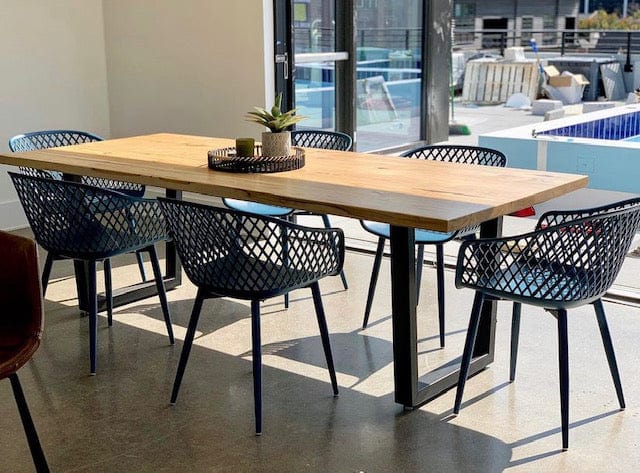Just how to Pick the Perfect Dining Room Table Legs for Your Home Decor
A Comprehensive Check Out Table Leg Styles: Finding the Perfect Suit
Selecting the best dining table leg style is crucial for both visual charm and functional performance. Conventional four legs use ageless elegance and security, while the pedestal base provides raised legroom and a contemporary look. For those with bigger tables, trestle legs guarantee sturdy assistance, whereas hairpin legs present a mid-century contemporary ambiance with their minimal design. The x-shaped legs mix contemporary design with enhanced security. Each of these choices brings unique advantages, making the choice greater than just a matter of preference. Check out even more to uncover which style flawlessly complements your eating space and way of living.
Standard 4 Legs
Amongst the numerous kinds of eating table leg styles, the conventional four-leg design continues to be a classic option for numerous homes. Four legs provide well balanced assistance, making sure the table stays steady and capable of bearing significant weight (dining room table legs).
From a visual point of view, the conventional four-leg design can be conveniently adjusted to different interior designs. Whether crafted from timber, metal, or a mix of products, these legs can be elaborately carved, streamlined and minimalistic, or anything in between. Their adaptability enables them to match both rustic and modern setups effortlessly.
Furthermore, the straightforward framework of the four-leg style helps with convenience of motion and placement within an area. Unlike more complex bases, this design reduces blockages, offering ample legroom for restaurants. In summary, the typical four-leg dining table leg design marries enduring sophistication with useful capability, making it an astute selection for those seeking both kind and function in their eating furniture.
Stand Base
Often celebrated for its sophisticated and space-efficient layout, the pedestal base is a prominent option to the typical four-leg configuration in dining table leg styles. Without corner legs, restaurants are afforded better freedom of movement, making it an optimal selection for round and oblong tables that advertise even more intimate and inclusive gatherings.
Furthermore, the pedestal base's central support can manage significant weight, permitting making use of larger tabletops, such as marble or thick hardwood. This strength coupled with its aesthetic versatility makes the stand base a prominent selection in both typical and modern indoor setups. It can effortlessly incorporate with different style styles, from traditional beauty to minimalist modernity. Additionally, the central column itself offers a canvas for intricate designs and imaginative expressions, including an aspect of visual rate of interest below the table. In summary, the stand base integrates performance with style, making it a refined and sensible choice for diverse dining environments.
Trestle Legs
Trestle legs give site here a durable and timeless structure for dining tables, identified by their horizontal cross-bracing and tough support beams. Stemming from medieval times, this style has progressed yet retained its important framework, making it a perennial fave in both conventional and modern settings. The main trestle beam, commonly supported by 2 or even more vertical blog posts, provides phenomenal stability, enabling larger table sizes without the need for extra legs.
A significant benefit of trestle leg tables is the adequate legroom they offer. Unlike tables with four edge legs, the absence of obstructions look at more info at the table's sides provides unimpeded area for chairs and restaurants, enhancing convenience and access. This makes trestle tables optimal for suiting larger events, whether in a dining-room or a banquet hall.
From rustic farmhouse to streamlined modern-day layouts, trestle legs can be tailored to match specific preferences. Their long-lasting appeal and functional benefits make trestle legs an engaging choice for those looking for both style and functionality in their dining table.
Hairpin Legs

The appeal of barrette legs exists in their simplicity and adaptability - dining room table legs. Available in a variety of products, consisting of steel and brass, they can be finished in many shades to complement different interior designs. Whether coupled with a rustic wooden tabletop or a contemporary glass surface area, Visit Your URL barrette legs effortlessly blend performance with a touch of classic beauty
Resilience is one more remarkable attribute of hairpin legs. Despite their delicate look, these legs are crafted to bear considerable weight, making sure the table remains stable and protected. Furthermore, they are fairly simple to install, making them a popular option for DIY lovers and expert furnishings manufacturers alike.
X-Shaped Legs

Built from products such as steel, wood, or a mix of both, X-shaped legs can be customized to match numerous style choices. Steel legs often lend a streamlined and industrial feel, ideal for loft-style apartments and contemporary dining areas. On the other hand, wooden X-shaped legs supply a warmer, extra rustic appeal, ideal for farmhouse or diverse interiors. The flexibility in materials allows property owners to personalize their dining tables to better fit their general layout system.
Moreover, the engineering behind X-shaped legs makes sure even weight distribution, minimizing the threat of tottering and boosting resilience. This makes them specifically fit for larger table that call for additional assistance. Basically, X-shaped legs mix useful engineering with contemporary aesthetic appeals, making them an ageless choice for diverse eating environments.
Verdict
A thorough understanding of dining table leg designs exposes the unique attributes and benefits of each style. Trestle legs guarantee robust assistance for larger tables, and hairpin legs present a mid-century modern aesthetic.